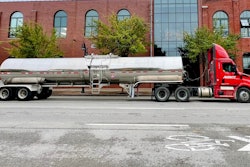
For those organizations with heavy duty transportation fleets hungry to improve their safety inspection and incident violation measures, it’s pretty simple – focus on a better B.L.T.
No, we’re not talking about making a better sandwich, this is all about Brakes, Lights, and Tires.
All of this should be top-of-mind for these organizations because August 24-30 is the annual CVSA Brake Safety Week. However, this topic has been a big item on the menu all summer long, beginning with the start of International Roadcheck earlier in May.
Taking a bite out of safety violations
BLT and the broader topic of truck safety is important, simply because of the statistics that continue to pour in. According to the National Highway and Transportation Safety Administration (NHTSA), large truck crashes continue to kill more than 5,000 people per year.
Tracking your BLT and broader maintenance health has never been more important. In fact, maintenance trends, vehicle safety and incident violation data have become so important that organizations have begun to benchmark their safety scores with fleet-specific KPIs to help improve operations and elevate their overall CSA (Compliance, Safety, Accountability) scores. According to the most recent TRUST Safety Index, violations tracked for the top private fleets across the U.S. showed a 50% rate for tires, 33% for brakes, and 17% for lighting.
Furthermore, according to the most recent 2025 NPTC Benchmarking Survey Report, tires (48%), brakes (25%), and lighting (14%) remained the leading causes of truck breakdowns.
Brakes
Brake systems are obvious critical safety components. Brake drums and rotors are essential to brake system performance, and issues like cracks, rust, or heavy wear can reduce a vehicle's stopping power and drastically increase stopping distance. Current regulation has dictated the stopping distance for a three-axle tractor grossing 59,600 lbs. should stop in less than 250 feet compared to previous of 355 feet.
There is more than one type of braking system and understanding the different components, operation, and inspection procedures are important. During a brake inspection it is important to remember that the entire brake system should be considered; this includes the following: the brake pedal, brake fluid, brake lines and hoses, and the brake assemblies (drum or disc).
To help improve and maintain brake performance, maintenance teams and drivers should check for contamination, visible damage, and proper component clearance. They should also address issues like heavily rusted or grooved rotors/drums immediately, as they indicate dangerous wear or inoperative brakes. Ensuring proper brake inspection and maintenance is not just a regulatory concern but an important step to prevent accidents, avoid citations, and save lives.
Lights
Maintaining proper lighting is critical for heavy-duty transportation fleets to avoid costly violations and ensure safety. Lighting issues are a major focus of inspections, and fleets can significantly reduce citations and downtime by implementing proactive maintenance programs. In fact, lighting violations are often considered “gateway” infractions by inspectors, meaning a malfunctioning light can lead to a more thorough inspection of a truck, potentially uncovering other, more severe violations. These issues are easy for inspectors to spot, as lights either work or they don't, making diligent maintenance a straightforward way to prevent problems.
To combat lighting violations, fleets should focus on several key areas: Drivers should perform daily checks of all lights, reflectors, and turn indicators before and after every trip. This should be part of a thorough pre- and post-trip inspection and should include headlights, taillights, brake lights, turn signals, and marker lamps. Any issues should be reported and fixed immediately.
Fleets can also significantly reduce violations by implementing systematic maintenance programs, which include scheduled lighting inspections as part of regular servicing. Lights should be kept clean and free from mud, grime, and debris to guarantee optimal visibility. Dirty lamps may not emit sufficient light and are more likely to be noticed by inspectors as potential violations.
Additionally, regularly inspect wiring, connectors, and protective covers for corrosion, wear, or damage. Corrosion from moisture or road salt is a leading cause of lighting failures, especially in LED systems. Lastly, replace defective bulbs, lenses, or entire lights as soon as issues are identified. For LED systems, even a single dark diode can cause a violation. By following these best practices, fleets can significantly reduce lighting-related safety violations and the resulting impact on CSA scores and operational costs.
While LED lights may be standard in many applications, the industry is still slowly phasing out incandescent bulbs. There are many benefits to spec an asset with LED or retro fit an older incandescent fleet to LED bulbs. LEDs use 90% less energy than standard bulbs which slightly decreases fuel consumption. LEDs are brighter and more responsive than incandescent which may decrease the chance of a rear end collision.
Tires
For companies with heavy-duty transportation fleets, prioritizing tire maintenance and safety is essential for both operational efficiency and safety. Proper tire management includes a few key areas. First, it's vital to choose the right tire for your fleet’s specific application. The correct tire can lead to better fuel efficiency, fewer road failures, and improved up-time and customer satisfaction.
Next, air pressure is a critical factor. Underinflated tires can reduce miles per gallon (MPG), generate excessive heat, and lead to accelerated wear and blowouts. Always check tire pressure when the tires are cold, and remember that pressure changes by about 1 psi for every 10°F change in ambient temperature. A tire pressure gauge is the only true way to confirm accurate tire pressure. The long-outdated practice of utilizing a hammer to check tires will merely tell you if the tire is completely flat and not underinflated. Regular pre-trip and post-trip inspections are the first line of defense against these issues.
To ensure compliance with regulations and prevent roadside failures, fleets should equip their teams with the right tools, like cut-resistant gloves, a calibrated air gauge, and a tread depth gauge. The U.S. Department of Transportation (DOT) requires a minimum tread depth of 4/32nd on steer tires and 2/32nd on all other tire positions.
Investing in consistent tire monitoring and maintenance helps fleets avoid costly out-of-service orders, fines, and delays, while also protecting the company's safety record and credibility.
Why data makes A difference
Having all of this knowledge is one thing, making it actionable for the benefit of your organization is another. Advanced data and analytics continue to modernize truck equipment renewal by providing unprecedented insight into vehicle utilization, performance and health. This wealth of information allows for predictive maintenance, which moves beyond scheduled servicing to anticipating and addressing issues before they cause costly breakdowns and downtime.
Similarly, trusted asset management partners enhance this process by leveraging their expertise and advanced analytics platforms. These partners can analyze a fleet’s data to develop a data-driven, multi-year renewal strategy that identifies the optimal time to replace a truck. This is determined by factors like the total cost of ownership, including maintenance expenses and fuel efficiency, against the benefits of new equipment with advanced safety and fuel-saving features. By providing this strategic guidance, asset management partners help organizations transition to the safest, most technologically advanced vehicles, improving safety, operational efficiency, and overall profitability.
Remember, think of data as your mayonnaise. With better data, you’ll always have a better BLT.













